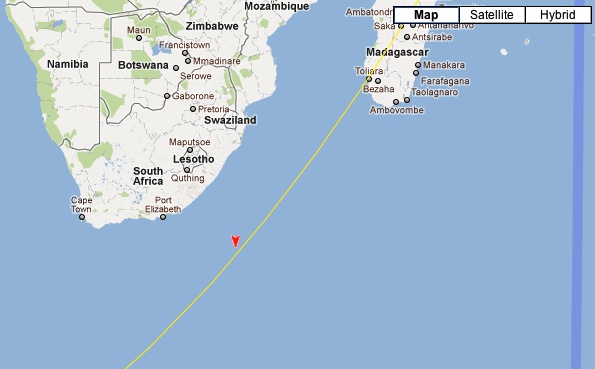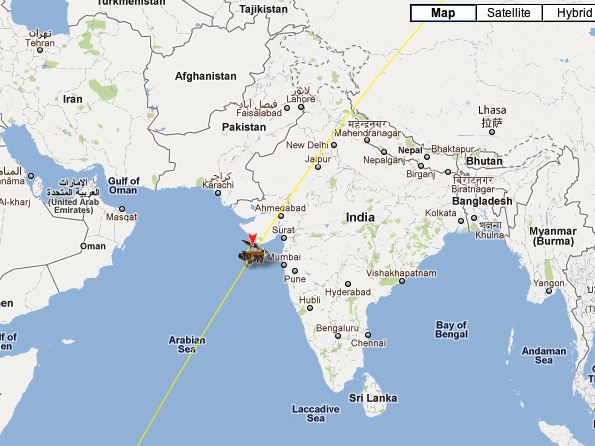
Screen shot of UARS tracking graphic from n2yo.com at about 8:50 a.m. CDT showing satellite headed over Madagascar (Chicago time).
UPDATE: The satellite is reported to have fallen as it was traveling eastward over Canada, the Atlantic Ocean and Africa between 10:23 p.m. CDT Friday September 23, 2011 and 12:09 a.m. CDT Saturday September 24, 2011.
Video of a pass of UARS satellite 9 days before atmospheric reentry, at an altitude of only 250km, taken from the ground with a 14″ telescope (Thierry Legault – Emmanuel Rietsch).
Live, real time tracking of the UARS satellite was available at n2yo.com. Users occasionally had to wait while the server was too busy and response was sometimes slow. Now the web page shows screen shots of the region of Canada and Africa of the last known orbital track as the UARS satellite was falling. On Friday night about 8:30 p.m. one of the earlier orbital tracks traveled southwest to northeast over Missouri and Chicagoland.
The Upper Atmosphere Research Satellite (UARS), an satellite in NASA’s Mission to Planet Earth, was launched from the Shuttle (STS 48) September 12, 1991 to provide data for better understanding of the Earth’s upper atmosphere and to understand the effects of natural and human interactions on the atmosphere. The objectives of the UARS mission were to conduct research in the atmosphere above the tropopause by measuring the global budget of constituent trace gases and their chemical, dynamic,and radiative behavior. The satellite was deployed from the Space Shuttle on September 15, 1991.
NASA Tracker Out of Service Until 2012
We apologize for the temporary service disruption of the J-Track Satellite tracker. This application was developed in the late 1990’s using technologies that are no longer supported. NASA is working to rebuild the satellite tracker with modern technology and hopes to have the tracker back on line by the start of 2012. In the interim, we would like to direct you to NASA SkyWatch— NASA
NASA SkyWatch does not include coverage for UARS.
UARS was the first multi-instrumented satellite to observe numerous chemical components of the atmosphere for better understanding of photochemistry. UARS data marked the beginning of many long-term records for key chemicals in the atmosphere. The satellite also provided key data on the amount of light that comes from the sun at ultraviolet and visible wavelengths. UARS ceased its productive scientific life in 2005.
The UARS satellite is expected to fall from orbit during the afternoon of September 23, 2011, Eastern Daylight Time.

Screen shot of UARS tracking graphic from n2yo.com at about 9:08 a.m. CDT showing satellite headed over India (Chicago time). The satellite was tracked over China four minutes later.
Thousands of objects can be tracked in real time on n2yo.com, which is a website providing mainly satellite tracking Services. The software used for tracking is using mainly space surveillance data provided by “Space Track”, a website consisting of a partial catalog of observations collected by the US Space Surveillance Network, operated by US Air Force Space Command (AFSPC). AFSPC does not make any warranties as to the accuracy or completeness of the data provided and does not endorse any product or service that utilizes its data.
n2yo.com is an authorized redistributor and the license is renewed annually. In special circumstances for a few satellites the traking data (“keplerian elements”) are derived from public sources (monitoring or visual observation). Users can specify their own location in order to have a better tracking experience. Registration is required to customize locations. Otherwise default locations are assumed based on the user’s IP address.
